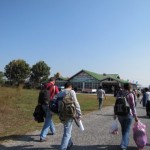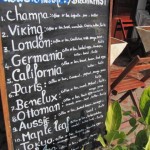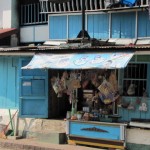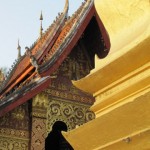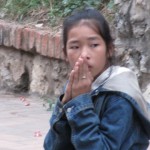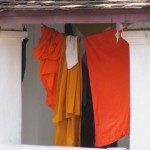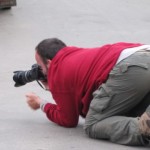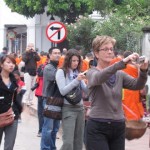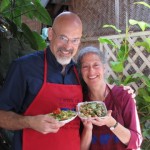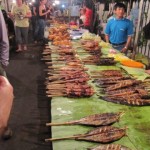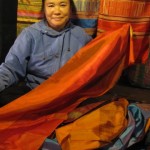We’re still half asleep but it’s a quick, easy ride to the Vientiane airport at 6:00 a.m. There’s a very nice Canadian (of course) guy in front of us at check-in who’s trying to reallocate his books and papers in order not to exceed the weight limit. Later, we have an interesting conversation about the weeklong international conference on UXO that just wrapped up in Vientiane. I learn more about the treaty (which the big players – the US among them – did not sign); the use of bombies in recent and ongoing conflicts today; and the manufacturing of “safe” bombies. It is a mind-blowing (no pun intended) concept to me.
We touch down in Bangkok a few hours later and Alan’s wonderful work rep is there to greet us. Phase Two of our trip has begun.
After a series of cell phone exchanges, we meet the two women who the rep has arranged to “take care of” me. We have no idea how or if they’re related to Rep or their role other than “software engineer’s partner handler.” They’re both dressed very, very casually. Eung is 44 and looks 30-something, I think, and very pretty. Pink, as I call her because she is wearing rose colored, skinny jeans, is 59. “Harriet” is impossible to pronounce so we shorten it to “Hallee” and eventually to “Alee.” We meet. They proceed to talk only to each other. I’m thinking this is going to be a very long, awkward week.
Alan and Rep climb into the front seat of the SUV. Eung and Pink open the back doors and, like women everywhere, they think they are fat and indicate that I should sit in the middle on the hump. Of course, they are not fat at all. Pink still looks good in her skinny jeans. Eung is thin and 4 inches taller than me. However, after not having passed up a single grain of sticky rice all month, by the time we fly out of Bangkok, I will have made up the 4 inches in girth.
Within minutes, Pink opens a big Tupperware bowl of sliced fruit that tastes something like a mild apple with a less dense texture. Then she cuts open a yellow pomegranate with juicy seeds the size of peanut M&Ms. Eung explains that Pink is always eating, cooking or talking about food. Over the course of the week I will learn that this is an understatement. (Note to Marla, Richard, Gayle: Another sibling in Thailand?) Alan and Rep make small talk. The women talk almost non-stop. They are loud and rowdy. They laugh easily, often and loudly. Later, I find out they thought I was 10 years younger. Funny – I never thought of a gray ponytail and pair of Tevas as age-defying fashion.
We drive almost two hours on a 6-lane freeway until it narrows, lane by lane, and we find ourselves in the bowels of Pattaya. We drive through the ugly, traffic-clogged streets lined with tawdry hotels, German beer gardens, massage parlors, discos, billboards for cheap high-rise condominiums, souvenir shops and loud motorbikes that carry scantily clad, bulging, sunburned Europeans. The two-story McDonald’s stands out as one of the most attractive buildings. Honestly.
I’m grateful not to have been in one of the minivans of our recent excursions, but I have been sitting in a tuk-tuk, then on a plane, and now on the middle bump and my ass is killing me. Rep wants to continue the driving tour through Hell and it takes another 45 minutes before we reach the waterfront restaurant. The first Singha is poured (over ice) and I realize that after less than half a glass, I’m already getting a buzz. I think I should at least wait until I get a little food in me, but the more I drink, the less I feel my aching buttocks. The first dish comes out. It is green papaya salad, this time with less lemongrass than its Lao cousin, but with more lime juice and chiles. Forget my butt; I can’t feel my lips.
It makes Rep and the women very happy that I can – and do – eat like a water buffalo. They are very pleased with Alan’s capacity as well, but we later learn that Eung can drink him – and pretty much anyone we know – under the table.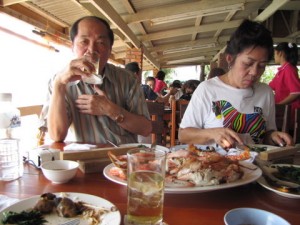
We pile back into the SUV after the papaya salad; cotton fish in garlic and ginger; delicate greens; rice; fish in spicy garlic oyster sauce; a heaping platter of huge crabs; another fish that’s poached with garlic, ginger and chiles in a rich broth and ends up in our soup bowls; salacca, another fruit with a slightly floral orange mango flavor, floating in a simple syrup; and probably a few other things, but I’ve been sucking down diluted Singha beers through my singed lips and can’t remember much at this point and have begun to pray we’re now on the way to our hotel.
Eung, Pink and I take our positions. Eung asks, “You have enough?” to which I reply “Too much” and pat my bulging belly. Not five seconds later, Pink whips the top off the Tupperware and starts in on the sliced fruit again. The three of us burst into hysterics. Okay, I’m going to have a good time with these women.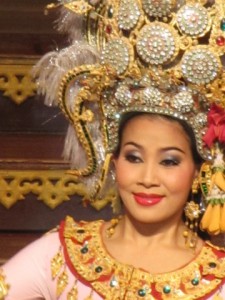
ARE WE THERE YET?
We’ve been up since 4:30 a.m. It’s now after 2 p.m. Sattahip is about 30 kilometers south of Pattaya. I can make it another 45 minutes. Oh, but wait. Rep first wants to take us to their famous zoological gardens. It is a Thai Disneyland/botanical garden/zoo/“cultural center”/amusement park filled with everything from fields of fake pink flamingos to drugged baby tigers; model stupas, pagodas and temples; a forest built out of stacked flower pots; and two different shows of colorful dancers, traditional music, Thai boxing and elephants painting pictures, playing soccer and throwing darts. How many Singhas did we have anyway? Probably not enough.
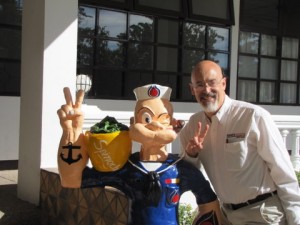 We are thrilled to finally reach the Navy hotel in sleepy, peaceful Sattahip. The décor is nautical of course, but the color scheme is powder puff pink. There’s a Popeye statue out front. Vandenburg, it is not.
We are thrilled to finally reach the Navy hotel in sleepy, peaceful Sattahip. The décor is nautical of course, but the color scheme is powder puff pink. There’s a Popeye statue out front. Vandenburg, it is not.
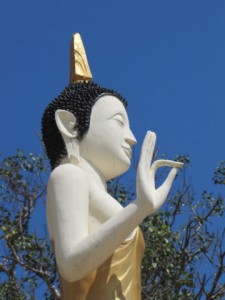
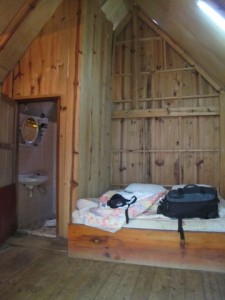 Built by the owner when he was a child 20-plus years ago, the two-story French colonial home sits beside the restaurant/bar and a half dozen cottages. We’re lucky to nab the the last one. En suite bathroom. 60,000 kip. About $7.50. Score.
Built by the owner when he was a child 20-plus years ago, the two-story French colonial home sits beside the restaurant/bar and a half dozen cottages. We’re lucky to nab the the last one. En suite bathroom. 60,000 kip. About $7.50. Score.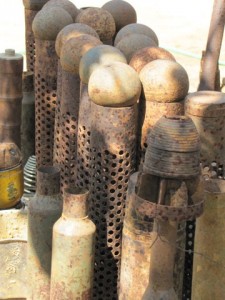 We drop some money there. Not enough. It can never be enough. We’re in the province most heavily bombed in the war. The US dropped more than 2 millions tons of bombs here — more than on Germany and Japan combined in WWII. Thirty-five years later, the bombing of this peaceful place continues with UXO being inadvertently detonated by farmers, scrap metal collectors, pond diggers and children.
We drop some money there. Not enough. It can never be enough. We’re in the province most heavily bombed in the war. The US dropped more than 2 millions tons of bombs here — more than on Germany and Japan combined in WWII. Thirty-five years later, the bombing of this peaceful place continues with UXO being inadvertently detonated by farmers, scrap metal collectors, pond diggers and children.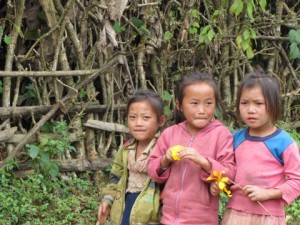
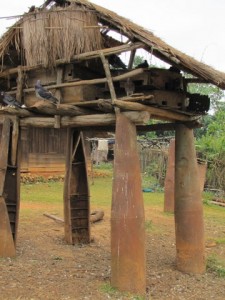 There is no animosity toward the U.S. now, but there is a very reasonable frustration that efforts/money to deal with UXO are slow and small. There is a well-founded fear that his own newborn daughter and her generation will likely live their entire lives as a potential victims.
There is no animosity toward the U.S. now, but there is a very reasonable frustration that efforts/money to deal with UXO are slow and small. There is a well-founded fear that his own newborn daughter and her generation will likely live their entire lives as a potential victims.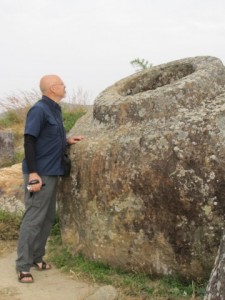 We’re intrigued by the mystery of how and why these gigantic stone jars exist — as are archaeologists — and the jars themselves are pretty cool, but I am a bit underwhelmed by the site itself. There could, however, be dozens or even hundreds more jars. Again, the presence of UXO hamper the discovery process. With funding from NZAID, UNESCO and others, MAG has cleared 127 UXO and provided markers to keep visitors on safe paths through the site. Laos will remain a poor country until all the UXO are eradicated. It is impossible to develop without an infrastructure, and that requires building the basics like roads, irrigation systems, schools, shelter.
We’re intrigued by the mystery of how and why these gigantic stone jars exist — as are archaeologists — and the jars themselves are pretty cool, but I am a bit underwhelmed by the site itself. There could, however, be dozens or even hundreds more jars. Again, the presence of UXO hamper the discovery process. With funding from NZAID, UNESCO and others, MAG has cleared 127 UXO and provided markers to keep visitors on safe paths through the site. Laos will remain a poor country until all the UXO are eradicated. It is impossible to develop without an infrastructure, and that requires building the basics like roads, irrigation systems, schools, shelter. 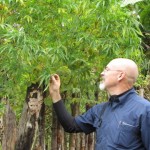
 f you don’t count the 90 minutes of trolling guest houses for other riders, van driver negotiations, and passenger swapping at the northern bus terminal. The minivans appear to be relatively new Hyundais and Toyotas – except for ours – an aged, shockless, padless, 12-seater, belching diesel exhaust inside and out. Those of us in the back half have fashioned face masks from whatever we’ve crammed into our day bags, not that any of us would have thought ahead to pack air filters in our packs now strapped precariously to the top of what we think might be some passive-aggressive attempt at payback for the “Secret War.”
f you don’t count the 90 minutes of trolling guest houses for other riders, van driver negotiations, and passenger swapping at the northern bus terminal. The minivans appear to be relatively new Hyundais and Toyotas – except for ours – an aged, shockless, padless, 12-seater, belching diesel exhaust inside and out. Those of us in the back half have fashioned face masks from whatever we’ve crammed into our day bags, not that any of us would have thought ahead to pack air filters in our packs now strapped precariously to the top of what we think might be some passive-aggressive attempt at payback for the “Secret War.”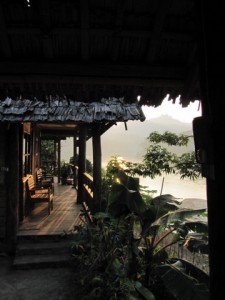
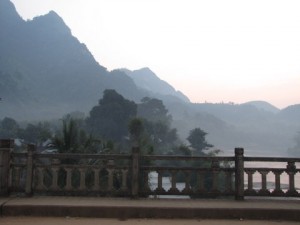 We trek up the road and stop at a restaurant where I proceed to have a little heat stroke while Alan continues the search. The champion hunter-gatherer has scored us a place close by, nearly as nice as the first, also on the riverfront, for a mere $16. He’s not a good bargainer so we’re likely paying an extra $6, but I’m happy to pay anything at this point.
We trek up the road and stop at a restaurant where I proceed to have a little heat stroke while Alan continues the search. The champion hunter-gatherer has scored us a place close by, nearly as nice as the first, also on the riverfront, for a mere $16. He’s not a good bargainer so we’re likely paying an extra $6, but I’m happy to pay anything at this point.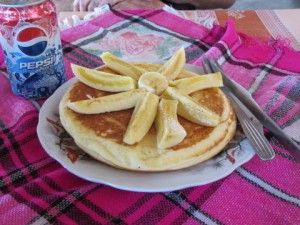
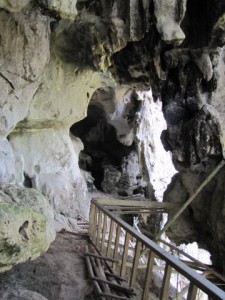 Along the way, we meet only an elderly French couple who travel as roughly as any young backpackers we’ve known. They tell us about several nights sleeping on the floor of a boat as they cruised up the Mekong. We don’t complain about our ride out of town in an air-conditioned minivan.
Along the way, we meet only an elderly French couple who travel as roughly as any young backpackers we’ve known. They tell us about several nights sleeping on the floor of a boat as they cruised up the Mekong. We don’t complain about our ride out of town in an air-conditioned minivan.